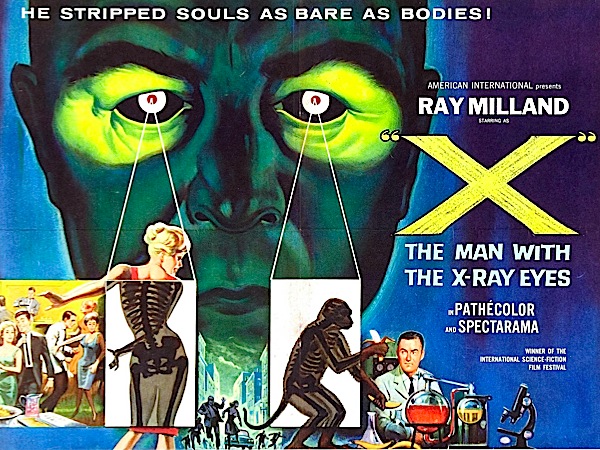o this writer, the film is Roger Corman’s best entry into sci-fi. Many of his 50s efforts hold a certain campy charm, with their low-budget effects – and this film is similar in that regard. It does not dwell on the effects, in fact some of them are rather poor. What it does have in its favor is a tight screenplay that gets into the story quickly, as will the viewer – and it’s engrossing enough and the characters interesting enough that one stays involved through the episodic story.
What it has most in its favor is an excellent performance from Ray Milland, then in his last days being top-billed, and he milks it for all that it’s worth. In some scenes Corman goes for a direct close-up and Milland’s facial reactions indicate that he took the the role in a small-budget/tight schedule film with all the enthusiasm that he did in one of his roles for Alfred Hitchcock (“Dial M For Murder”) or Fritz Lang (“Ministry of Fear”). Smooth, refined, but a man of immediate action if necessary, Milland’s Dr. Xavier is not your usual mad scientist. As with Claude Rains in “The Invisible Man” or Al Hedison in “The Fly” he’s the scientist who made the mistake of being his own subject.
Occasionally Corman goes for the cheap gag (the party sequence, where Xavier examines the guests sans attire – but inoffensive in a typical 60s approach), but the carnival scenes and the basement healer scenes show a maturity to Corman’s direction, and these scenes are greatly helped by the performance of Don Rickles. He’s as sleazy as one can get and admits that if he had the power, he would use it to see “all the undressed women my poor eyes can stand” and you believe it. A scene where Milland confronts other carnival workers who are speculating on his “power” shows the doctor to be both introspective and world weary at the same time. At this point even he does not know what to do with his ability, but Rickles’ suggestion of setting up a site to “heal” others leads to the film’s most revealing and almost poetic sequence. Xavier’s original intention was to help the ill, but his implication in an accidental murder led him to seek refuge in the carnival Richard Kimble-style.
Diana Van Der Vlis does well with her underwritten role in which at one point she’s rather quickly dropped, and then resurfaces rather conveniently later in the story – to no great effect. This was only her second feature film, though she had done a number of TV guest shots. Although half Milland’s age, she seems more mature than her 28 years and they make a believable pair. A bonus is the appearance of a number of veterans in brief roles – John Hoyt, Harold J. Stone, John Dierkes and Morris Ankrum, as well as Corman stalwart Dick Miller. Miller shares his scenes with Jonathan Haze, whom it appears was getting the cheapest rate Corman could pay as he has no lines at all. He was rather bitter about this as he revealed in an interview years later.
Floyd Crosby’s cinematography belies the small budget – only $300,000 and a shooting schedule of about three weeks. According to Corman they did rehearse a bit more than usual – and in the finished product it shows. He claims he even went as high as four takes, which may not exactly put him in William Wyler or Stanley Kubrick territory, but it’s a far cry from what he’d do in the 50s. Les Baxter contributes what may be my favorite of his scores, fully complimentary to the action on screen without overwhelming it.
There’s a bit of controversy over the ending – some attribute an extra line of dialog that never appeared in any print that I’ve seen, but it is still one of the most surprising endings of any sci-fi film since “The Incredible Shrinking Man.” That it won the top prize at the Trieste Science Fiction Film Festival would be enough for one to be curious enough to see it even this many years later – that it has held up so well over 40 years points to that award’s validity.

